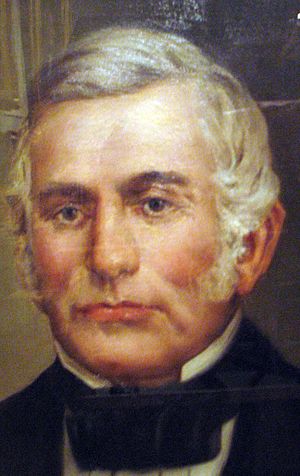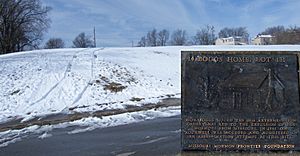Lilburn Boggs facts for kids
Quick facts for kids
Lilburn Boggs
|
|
|---|---|
 |
|
| Governor of Missouri | |
| In office September 30, 1836 – November 16, 1840 |
|
| Lieutenant | Franklin Cannon |
| Preceded by | Daniel Dunklin |
| Succeeded by | Thomas Reynolds |
| Lieutenant Governor of Missouri | |
| In office November 19, 1832 – September 30, 1836 |
|
| Governor | Daniel Dunklin |
| Preceded by | Daniel Dunklin |
| Succeeded by | Franklin Cannon |
| Personal details | |
| Born |
Lilburn Williams Boggs
December 14, 1796 Lexington, Kentucky, U.S. |
| Died | March 14, 1860 (aged 63) Rancho Napa, California, U.S. |
| Political party | Democratic |
| Military service | |
| Allegiance | |
| Battles/wars | War of 1812 |
Lilburn Williams Boggs (December 14, 1796 – March 14, 1860) was the sixth Governor of Missouri. He served from 1836 to 1840. He is known for his actions during a time of conflict in Missouri. This included a special order called the "Extermination Order." He was also involved in a border dispute known as the Honey War.
Contents
Early Life and Political Career
Lilburn W. Boggs was born in Lexington, Kentucky on December 14, 1796. His parents were John McKinley Boggs and Martha Oliver. He served in the Kentucky troops during the War of 1812 for 18 months.
Moving to Missouri
In 1816, Boggs moved from Kentucky to Missouri. At that time, Missouri was part of the Louisiana Territory. He helped start the town of Smithton, which later became Columbia, Missouri.
Family Life
In 1817, Boggs married Julia Ann Bent in Kentucky. She was the sister of the famous Bent brothers of Bent's Fort. Julia died in 1820. They had two children, Angus and Henry.
In 1823, Boggs married Panthea Grant Boone. She was a granddaughter of the famous pioneer Daniel Boone. They lived in Jackson County, Missouri, where most of their many children were born.
Political Journey
Boggs started his career as a clerk. He then entered politics. He served as a state senator in Missouri from 1825 to 1832. After that, he was the lieutenant governor from 1832 to 1836. He then became governor from 1836 to 1840. Later, he served again as a state senator from 1842 to 1846. He was a member of the Democratic Party.
The Extermination Order
While he was governor, Boggs issued a special document called Missouri Executive Order 44. In Latter Day Saint history, this document is known as the "Extermination Order."
Reasons for the Order
This order was issued on October 27, 1838. It was a response to growing problems and violence. This time is known as the 1838 Mormon War in Missouri. The order stated that Latter Day Saints should be forced out of the state. Boggs said they were "enemies" and had "made war upon the people of this State."
Order Rescinded
This order stayed in effect for almost 138 years. On June 25, 1976, Missouri Governor Kit Bond officially canceled it. Governor Bond said the original order went against the legal rights in the U.S. Constitution. When he canceled the order, Governor Bond expressed regret on behalf of the state.
Assassination Attempt
After leaving office, Boggs moved to a house in Independence, Missouri. On the evening of May 6, 1842, someone shot Boggs through a window. He was reading a newspaper in his study at the time. Boggs was badly hurt. Many doctors thought he would die. Some newspapers even printed his obituary. But to everyone's surprise, Boggs slowly got better and survived.
Investigation and Suspects
Sheriff J.H. Reynolds investigated the crime. He found a gun at the scene. It was still loaded. The gun had been stolen from a local shop. The shopkeeper said a man named Porter Rockwell was the "most likely culprit." Rockwell was known to be close to Joseph Smith.
Sheriff Reynolds arrested Rockwell. He held him for almost a year while waiting for a trial. However, Reynolds could not find any proof that Rockwell was involved. With the help of lawyer Alexander Doniphan, Rockwell was found not guilty of all charges.
Different Opinions
Some people had different ideas about the shooting. A pro-Mormon newspaper called The Wasp wrote that "Boggs is undoubtedly killed." They wondered who "did the noble deed." Rockwell himself said he had "done nothing criminal."
Another person, John C. Bennett, claimed that Joseph Smith had offered money to anyone who would shoot Boggs. He also said Smith admitted Rockwell did it. Joseph Smith strongly denied Bennett's claims. He thought Boggs might have been attacked by a political opponent. Historians still debate who was responsible for the shooting.
Moving West to California
In 1846, Boggs traveled overland to California. Many people believed he moved because he was afraid of the Mormons. He traveled with his second wife, Panthea, and his younger children. His son, William, and William's wife, Sonora, also came along.
Life in California
They arrived in Sonoma, California in November. They were welcomed by Mariano Vallejo. On January 4, 1847, William's wife gave birth to a son. They named him Mariano Guadalupe Vallejo Boggs after their kind host.
Lilburn Boggs became a local leader, called an alcalde, in the Sonoma area in 1847. During the California Gold Rush, Boggs owned a store and did very well. In 1849, he became the town's postmaster.
Boggs was elected to the California State Assembly from the Sonoma District in 1852. In 1855, he retired to Rancho Napa in Napa County, California. He died there on March 14, 1860. His wife, Panthea, died in 1880. They are buried in Tulocay Cemetery in Napa, California.
His son, Theodore Boggs, later founded the town of Big Bug, Arizona.



